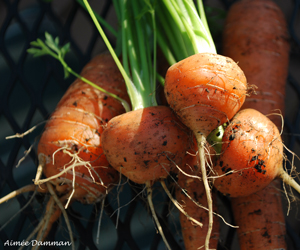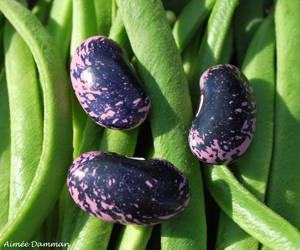Edible plants are a great way to introduce your kids to the wonderful world of gardening. They’re colorful, fast growing, and delicious! It’s exciting for kids to see fruits and vegetables sprout and grow in their own garden (some, like Brussels sprouts, look very different in the garden than on the dinner plate!) I’ve also noticed that kids are often more adventurous about trying a new vegetable when they have grown it themselves.
The key to creating a successful edible garden with kids is to keep it simple. Involve the kids in as many aspects of gardening as possible and choose plants that the whole family can get excited about growing. That doesn’t mean planting just the veggies and fruits they know and love, but also experimenting with “kid-friendly” varieties that are fun to grow, like rainbow Swiss chard, spotted beans or candy-striped Chioggia beets.
Here are a few tips to make creating an edible garden a fun and successful family endeavor!
 |  |
Start small
Choose a few easy-care vegetables of different types: roots (carrots, radishes, beets…), leaves (lettuce, Swiss chard, kale…), and fruits (tomatoes, peas, squash…) Add in strawberries (because everyone loves strawberries), some herbs (try a “pizza” herb garden!), and a few edible flowers, and you have the foundation of a well-rounded edible garden that also looks pretty and attracts pollinators.
Some favorite kid-friendly veggies and fruit
- Rainbow carrots or round baby carrots
- Easter egg radishes
- Rainbow Swiss chard
- Peas
- Mini pumpkins
- Cherry tomatoes
- Chioggia beets
- Purple potatoes
- Rattlesnake or purple beans
- Brightly colored lettuce, like ‘Merlot’ or ‘Flashy Trout’s Back’
- Strawberries
- Pansies
- Calendula
- Chives
- Basil
Before you start planting, it’s a good idea to plan and prep the area to be sure your vegetables will thrive. The more kids can be involved in the initial steps of preparing the soil, choosing what to grow, and designing the garden, the more invested they will be in tending to their plants.
Decide where to plant
Choose a spot that gets as much sunlight as possible, ideally up to 10 hours a day. You can build a raised bed, plant in an existing garden area (ornamental and edible plants can grow very well together), or create a container garden. If you are worried that you don’t have enough sun, try leafy greens, herbs like cilantro and parsley, or other shade-tolerant vegetables.
Prepare the soil
Garden soil can be enriched by the addition of nutrient-rich compost and soil-building conditioners, as well as organic fertilizer. For containers, choose a high-quality potting soil that adds nutrients and maintains proper drainage. Make sure your soil is weed-free and remove any large rocks before you begin planting.
 |  |
Plant your fruits and veggies
Read the planting directions on seed packets and plant tags to see how much room your plants will need to grow. If sowing seeds, you may eventually need to remove some sprouts so the remaining ones will have enough room to grow to a good size. These “thinned” sprouts aren’t wasted – lettuce, radish, spinach, and chard sprouts are delicious in salads or on sandwiches! After planting, be sure to water gently and deeply, then create a regular watering schedule. Sprouts and young plants are especially vulnerable to drying out.
Don’t forget to label your plants. Kids can have fun creating colorful plant name tags with popsicle sticks and markers or even paint rocks. Tags are especially helpful to mark areas where you have planted seeds that haven’t yet sprouted.
Tend to your garden
Keep an eye on your plants as they grow and inspect them for signs of insects or disease. A great activity to do with kids is to create a photo album or sketch book of the garden as it changes and grows. Some seed packets and plant tags tell you approximately how many days from planting to harvest, so you can mark your calendar and revel in the anticipation!
Monitoring your plants also allows you to highlight an important gardening lesson: sometimes plants die. Even if we do our best to take care of them, not all of our plants will thrive, but it’s not the end of the world! Allow your kids to be disappointed and gently encourage them to replant or try something new. Every gardener learns that experimentation is part of the fun. Help your kids become adventurous gardeners!
Gardening with kids teaches them about the natural world, inspires creativity and dedication, and is a great way to enjoy quality time together as a family (with the bonus of a delicious harvest!) It’s not only a rewarding experience for children, but for adults as well. Watching a child discover and delight in the garden is a joy for everyone.
Want personalized gardening advice? Reach out to us on social media using #heyswansons! You can also learn more on the Edible Gardening section of our blog or visit us in person for information and inspiration.


